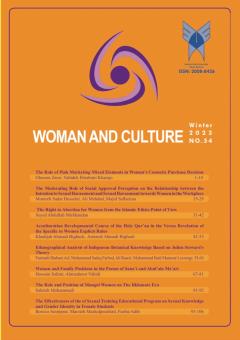جایگاه زن و خانواده در سرودههای سنایی و ابوالعلاء معری
الموضوعات :حسین سلیمی 1 , احمدنور وحیدی 2
1 - استادیار گروه زبان و ادبیات فارسی، دانشکده ادبیات و علوم انسانی، دانشگاه خلیج فارس، بوشهر، ایران.
2 - استادیار گروه زبان و ادبیات فارسی، دانشکده ادبیات و علوم انسانی، مجتمع آموزش عالی سراوان، سراوان، ایران.
الکلمات المفتاحية: جایگاه زن و خانواده, سرودههای سنایی, سرودههای ابوالعلاء معری,
ملخص المقالة :
هدف پژوهش حاضر بررسی جایگاه زن و خانواده در سرودههای سنایی و ابوالعلاء معری میباشد. جامعه پژوهش شامل دیوان اشعار سنایی و ابوالعلامعری است. نمونه پژوهش، ابیات گزینششده از سرودههای سنایی و ابوالعلا معری بود که بر مبنای نوع نگاه مثبت و منفی آنان نسبت به جایگاه زن و خانواده انتخاب شدند. روش این پژوهش توصیفی – تحلیلی است. برای تحلیل و مقایسه نگاه دو شاعر به موضوع، نمونههایی از سرودههای دو شاعر مطرح و مورد تحلیل و بررسی قرار گرفت. نتایج نشانداد که سنایی و ابوالعلاء معری دو شاعر نامی در ادب فارسی و عربی بودند که بیشتر از بقیه به تبیین و تحلیل جایگاه زن پرداختهاند. درعینحال، موارد همسان در جهانبینی آنها نسبت به زن و بنیان خانواده و همچنین، وجوه افتراق و تفاوت نیز در اندیشه آنان کم نیست. طبق اندیشههای سنایی، گاهی اشعار اجتماعی در باب زن و خانواده تابع احساسات بود. در مقابل اندیشه معری در باب زن و خانواده نهتنها ناشی از احساسات زودگذر نیست بلکه متأثر از یک نوع یأس و بدبینی عمیق فلسفی است که طی سالیان متمادی در درون او پرورده شدهاست. نکته دیگر این است که بسیاری از اظهارنظرها و بینشهای معری و سنایی نسبت به زن متأثر از اجتماع و شرایط اجتماعی روزگار آنها است و این در مورد سنایی بیشتر صدق میکند. به عبارتی بسیاری از باورها و عقاید عامه مردم جامعه در باب زن و خانواده در ذهن و زبان این دو شاعر نیز مؤثر افتاده است.
The Holy Quran.
Afrasiabpour, A. (2001). The authority of women and Hazrat Zahra (PBUH), from the perspective of the Ghaznavid Sana'i. Journal of Women and Culture, 2(6), 93-106. URL: https://jwc.ahvaz.iau.ir/article_523390.html
Bagheri, Kh. (2003). Philosophical foundations of feminism. Tehran: Office of Social Planning and Cultural Studies of the Ministry of Science, Research and Technology. URL: https://www.gisoom.com/book/1262268
Bahmani Mutlaq, Y., & Sharbat A. (2012). The position of women in Islamic mysticism and Sufism (Relying on the works of Sanai, Attar and Jam. Journal of Women and Culture, 3(10), 70-53. URL: https://jwc.ahvaz.iau.ir/article_523318_da156faa75f9559a7512d969b86c8aa4.pdf
Bakhtiar, M. (2009). Spiritual position of women in Islamic mysticism. Journal of Women and Culture, 11(44), 17-27. ]Persian[ URL: http://ensani.ir/file/download/article/1602059554-10314-99-264.pdf
Dadkhah, H, Golizadeh, P,. & Nazarpour, B. (2012). The position of women from the point of view of modern writers of Masrnovin, research paper on women, research institute of humanities and cultural studies, fourth year. Second Issue, 1(2), 73-83. URL: https://womenstudy.ihcs.ac.ir/article_1073_107e7ce0a3877c4d8fe883202fa7c8ff.pdf
Fatorehchi, M. (2005). The Society of Society in Sanai Works, Tehran: Amirkabir. ]Persian[. URL: https://www.gisoom.com/book/130869
Foroukh, O. (1963). Philosophical Beliefs of Abul Ala. Translated by Hossein Khadio Jam. (2001). Tehran: Pocket Books Organization. ]Persian[.URL: https://www.gisoom.com/book/11141420
Hosseini, M. (2004). The roots of feminism in classical Persian literature. Tehran: Amirkabir. ]Persian[ URL: https://www.gisoom.com/book/1620032
Javad, A. (1976). The detailed in the history of literature in pre-Islamic times. Beirut: Dar for the Science of Millions. ]Persian[ URL: https://www.noor-book.com/en/ebook.
Karimi, A. (2015). Criticism and review of the pessimistic philosophy of Sheikh Maara. New Religious Thought Quarterly, 11(42), 139-154.]Persian[ URL: http://andishe.maaref.ac.ir/article-1-296-fa.html
Ma'ari, A. A. S. (1999). Message Alghafran, Explanation and presentation of Salim Majaes. Tehran: Awaken to the distribution Shenro. ]Persian[ URL: https://ketabpedia.com
Ma'ari, A. A. S. (2000). The court of the necessity of Malaysia (Requirements). Beirut: Dar Al-Arqam Publishing House Ibn Abi Al-Arqam. URL: https://www.goodreads.com/book/show/53168587
Ma'ari, A. A. S. (2004). Divan Luzum Mala Yalzam. Beirut: Publisher of the Arabic Library. URL: https://lib.ui.ac.ir/inventory/1/48027.htm
Mirzai, P., & Gharavi Nayini, N. (2015). A new approach to the hadith "Dafn al-Banat Man Al Makramat. Hadith Sciences, 20(2), 120-136. ]Persian[ URL: http://hadith.riqh.ac.ir/article_12249_22e06c19e09205f4b247820c6b3a548c.pdf.
Naser Khosrow, A. N. (1991). Safarnameh. Tehran: Zavar. ]Persian[ URL: https://eliteraturebook.com/books/view/12961
Nasr, Z. (2003). An analysis of the place and position of women in lyrical, didactic and mystical systems. Scientific Research Journal of Faculty of Literature and Human Sciences, University of Isfahan, 2(32-33), 169-187. http://ensani.ir/file/download/article/20110208143822-%C2%A0%20(249).pdf
Noorian, M., Toghiani, E., & Saeed, H. (2005). Thematic sociology of Sana'i works. Exploration of Persian Language and Literature, 6(10), 63-92. URL: https://www.sid.ir/paper/101581/fa
Razazzadeh, Z., Haji Esmaili, M.R., & Mosleh, M. (2019). Formation of a woman's rational personality from the perspective of the Qur'an and Hadith. Journal of Women and Culture, 11(44), 17-27. URL: https://jwc.ahvaz.iau.ir/article_675195_4664572d0bdeb30e7be70d7486a460ac.pdf
Sajjadi, Z. (2006). An Introduction to Mysticism and Sufism. Tehran: Samt. URL: https://samt.ac.ir/fa/book/1651
Sanai, A. M. I. A. (2009). Divan Sanai. Tehran: Sanai Library Publications. ]Persian[ URL: https://eliteraturebook.com/authors/books/5501
Sanai, A. M. I. A. (1975). Divan Sanai. Tehran: Sanai Library Publications. ]Persian[ URL: https://eliteraturebook.com/authors/books/5501
Seyedi, H., & Adinekalat, F. (2018). Comparative study of the concept of death in the thought of Abul Ala Maari and Omar Khayyam Neishaburi. Journal of Comparative Literature, 1(2), 117-137. ]Persian[. URL: https://www.noormags.ir/view/fa/articlepage/596706
Shamisa, S. (2002). Witnessing in Persian Literature. Tehran: Ferdos Publications. ]Persian[ URL: https://joyabook.com/product//
Sharifiyan, M. (2010). Sociology of mystical Sana'i literature. Sociology of Irfan Senai literature, 1(2), 11-27. URL: https://www.sid.ir/paper/213713/fa
Zakavati Gharagozlou, A. (2016). A brief overview of the state and thought of Abul Ala Ma'ari. The Mirror of Research, 28(4), 13-22. URL: https://jap.isca.ac.ir/article_65230_23afb1d5b52ee90920f6317fc83c4ca3.pdf
Zarin Koob, A. H. (2007). With the Helle Caravan. Tehran: Scientific Publications. URL: http://elmipublications.com/product/bakarevaneholle
_||_

